Understanding the Worth of Emerald Rings Today
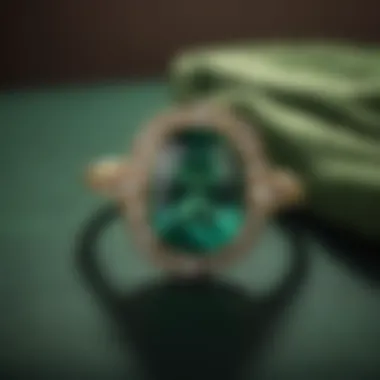
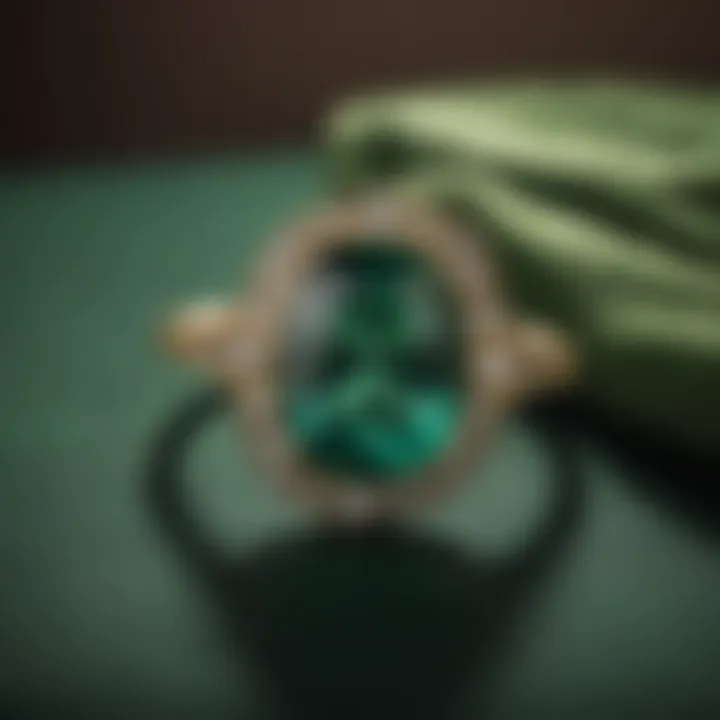
Intro
Emerald rings are more than just decorative pieces of jewelry; they encapsulate a rich history, unique stories, and a multitude of qualities that significantly influence their value. Understanding what makes these rings truly special requires diving into the finer details of the gemstones themselves, as well as their broader market dynamics. This article aims to shed light on the critical components that affect the appraisal of emerald rings, especially for those keen on investing in these exquisite jewels.
Gemstone Overview
Definition of Gemstones
Gemstones are naturally occurring, precious or semi-precious stones that are often cut and polished for use in jewelry. The term encompasses a variety of materials, including minerals and organic substances, which are prized for their beauty, rarity, and durability. Emeralds, a form of the mineral beryl, stand out due to their vibrant green color, which is primarily attributed to chromium and vanadium within their structure.
Classification of Gemstones
Gemstones can be classified in multiple ways, but the most prominent categories include:
- Precious Gemstones: This group encompasses the most sought-after stones—diamonds, rubies, sapphires, and emeralds. These stones command the highest prices and generally have a long-standing reputation in various cultures.
- Semi-Precious Gemstones: These are less rare and include stones like amethyst, turquoise, and garnet. While they can be beautiful and valuable, they often don’t reach the same price levels as the precious variety.
- Organic Gemstones: These include materials like pearls, amber, and coral, formed from living organisms.
Emeralds fit snugly into the 'precious' classification, further solidifying their desirability and market value.
Historical Significance
Origins of Gemstone Use
The fascination with gemstones dates back to ancient civilizations. From the Egyptians who treasured turquoise and lapis lazuli, to the Chinese who embraced jade, the allure of gemstones has transcended cultures and time. Emeralds specifically boast a colorful history that includes being cherished by the ancient Egyptians, who equated their vibrant green hue with fertility and rebirth.
Cultural Insights: Gemstones in Ancient Civilizations
Emeralds have captivated numerous civilizations throughout history:
- Ancient Egypt: Cleopatra, the iconic queen, famously wore emeralds, which further elevated their status.
- The Aztecs: They valued emeralds not only for their beauty but also as symbols of power and wealth.
- Medieval Europe: Emeralds were believed to possess healing properties, which led to their prevalent usage among aristocrats and royals.
Each of these cultural ties contributed to shaping the perception and worth of emeralds, making them an enduring symbol of luxury even today.
"Emeralds are not merely gemstones; they are a testament of a civilization's admiration for nature's wonder, echoing the whispers of history through the passages of time.”
Understanding the historical context of emeralds gives collectors and buyers a broader perspective on their value. By considering these intricate layers, one can make more astute decisions when evaluating the worth of emerald rings.
Prelims to Emerald Rings
Emerald rings are not merely beautiful adornments; they carry a depth of meaning and significance that few other gemstones can boast. Understanding the value of these rings goes beyond a simple assessment of their aesthetic appeal. This section sets the stage for a detailed exploration by highlighting the characteristics that set emeralds apart, their historical context, and what makes them coveted pieces in jewelry collections.
Emeralds, with their lush green hues, have fascinated humanity for centuries. They symbolize rebirth and love, making them a popular choice for engagement and wedding rings. Many collectors and jewelers seek to understand the factors that contribute to the quality and worth of these gems.
In examining the dynamics of emerald rings, we can better appreciate not just their beauty, but also the intricacies that affect their market value and desirability. Grasping this topic is essential for anyone keen on investing in emerald jewelry, whether they are seasoned collectors or newcomers to the world of gemstones.
What Makes Emeralds Unique?
Emeralds are unique due to their distinct color, which can range from deep green to a lighter sea green. This color is caused by the presence of chromium and vanadium, which imbue the gemstone with its characteristic hue. Unlike diamonds, emeralds are often included with natural imperfections, called "jardin" (meaning "garden" in French), that can enhance their charm rather than detract from it.
When it comes to emerald rings, their allure is often tied to the following factors:
- Color: The most important aspect, with more intense colors being more valuable.
- Clarity: Although inclusions are common, those with fewer blemishes are more sought after.
- Cut: The way the stone is shaped plays a role in how well it reflects light, impacting its vibrancy.
All these elements contribute to what makes emeralds stand out in a crowded market of colored gemstones.
Historical Significance of Emeralds in Jewelry
Emeralds have been cherished throughout human history. From ancient civilizations to modern times, they have held a place of reverence in various cultures. The Incas believed emeralds possessed magical properties and used them in religious ceremonies. Cleopatra, famed for her passion for emeralds, showcased the gemstone as a symbol of her wealth and power, wearing them as a sign of beauty and authority.
As centuries passed, emeralds continued to find a place in royal crowns and adornments. They were often set in elaborate jewelry pieces that not only highlighted the wearer's status but also their taste for intricate designs. This historical context allows contemporary buyers to understand the value of emerald rings not merely in monetary terms but as part of a rich legacy spanning ages and cultures.

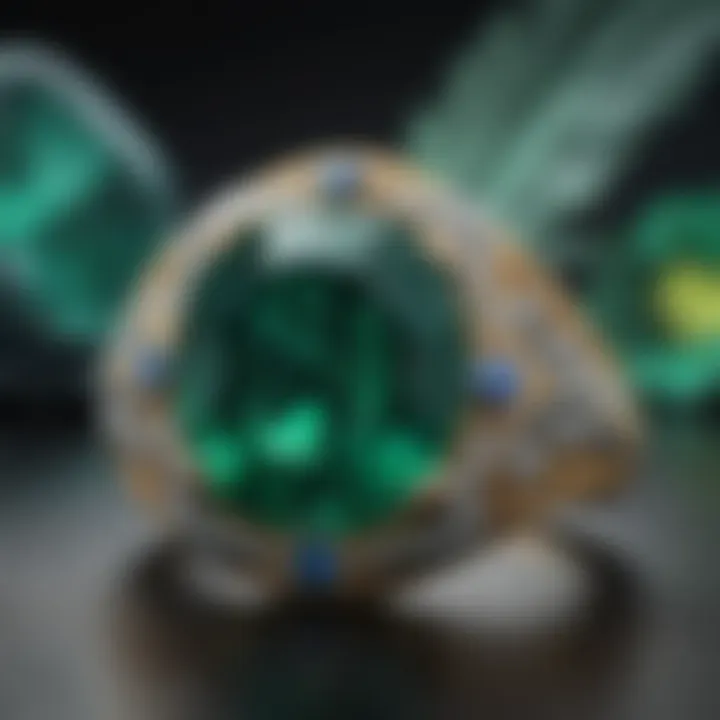
Moreover, the timelessness of emerald rings reflects their adaptability to different styles—whether vintage or modern—making them a versatile choice for jewelry enthusiasts.
Emeralds, much like the history they carry, are complex and layered, inviting deeper exploration for those willing to dive into their rich heritage and enduring appeal.
Factors Influencing the Value of Emerald Rings
Understanding how the value of emerald rings is determined is crucial for both buyers and collectors. Emeralds hold a unique position in the gemstone world—not just because of their stunning green color, but because several factors play into their overall worth. From the gemstone's weight and clarity to the intricacies of its cut, each element carries significance that can raise or lower a ring's market value. Additionally, recognition of these elements can empower buyers to make informed decisions and negotiate better deals. This section seeks to delve deep into the various factors that influence the valuation of emerald rings, spotlighting critical elements along the way.
The Role of Carat Weight
Carat weight is often the first consideration when someone evaluates an emerald ring. Simply put, the more carats an emerald holds, the more expensive it can be. This fact stems from basic supply and demand principles; larger gemstones are rarer and generally more sought after. However, the value is not strictly linear—while a one-carat emerald may fetch a certain price, a two-carat version could command a price that’s exponentially higher.
The allure of a larger stone can’t be denied. However, it's also important to consider that as carat weight increases, other factors like clarity and color may be compromised. Ultimately, a well-balanced ring—one that combines appropriate carat weight with top-notch clarity and vibrant color—will yield the best appreciation.
Clarity and Color Grading
Understanding Clarity Ratings
Clarity ratings describe the level of imperfections within a gemstone. This can include inclusions (internal flaws) and blemishes (external flaws) which affect an emerald’s brilliance and transparency. GIA, the Gemological Institute of America, uses a scale to classify clarity, spanning from "Flawless" to "Included". The clearer the emerald, the more valuable it generally is. A standout feature here is that many emeralds naturally contain inclusions known as "jardin"; this does not necessarily lessen their desirability but serves as a characteristic of authenticity.
Buying an emerald with a more appealing clarity grade can be a wise investment, although it’s important to remember that not all clarity issues hold the same weight. A gemstone may have visible inclusions but still be considered valuable if it has a striking color or excellent cut.
Color Saturation and Its Impact
Color is undoubtedly a fundamental element when assessing the value of an emerald. The grading of color includes hue, tone, and saturation. A gem's hue refers to its primary color—in this case, green—while tone relates to the lightness or darkness of that green. Saturation pertains to the intensity of the color; the richer and more vivid the saturation, the higher the stone's worth.
Emeralds with a deep, lush green value are often viewed as the epitome of the gemstone, making them a popular choice for collectors. Unique shades, such as those from Colombia, can fetch higher prices compared to lighter-colored options. So, understanding these color metrics is key to grasping the overall quality of an emerald ring.
Cut Quality and Its Importance
Cut quality can often go overlooked but holds equal importance in the appraisal of emerald rings. The cut defines how well the stone reflects light. A well-cut emerald will sparkle and catch the eye, enhancing its overall appeal. An ineffective cut, however, might lead to a dull appearance, regardless of the stone's carat weight or clarity.
For emeralds, the best cuts will often be shaped to maximize color and brilliance without compromising the stone's structural integrity. Shapes like the emerald cut itself are tailored specifically for the gemstone, allowing for its deep green hue to shine through while protecting fragile corners.
Emerald rings represent a marriage of art and nature; by understanding these factors, enthusiasts can appreciate the meticulous details that contribute to the value of these exquisite pieces.
Emerald Origin and Its Impact on Value
Understanding the origin of emeralds is essential for determining their value. The geographical source of an emerald significantly affects its quality, location-based characteristics, and market demand. Different regions produce emeralds with distinct qualities, and consumers often show preference for certain origins over others. Knowing where your emerald comes from can impact its valuation in various ways, from the cultural significance attached to the gemstone to its physical characteristics.
Geographical Sources
Emeralds are primarily sourced from three countries, each known for producing unique types of gemstones. These sources—Colombia, Zambia, and Brazil—each have their own reputations and characteristics that can influence an emerald's worth. Let's delve into each of these sources:
Colombian Emeralds
Colombian emeralds are often regarded as the gold standard in the emerald world. The vibrancy and depth of their color, a rich green often described as "greenest green," makes them highly sought after. Notably, Colombian emeralds usually have fewer inclusions when compared to emeralds from other regions, enhancing their perceived value. However, they can also be more expensive due to high demand and limited production.
- Unique Feature: The presence of "jardin" or garden-like inclusions is common in Colombian emeralds, and while these inclusions might decrease clarity, they often enhance the gemstone's uniqueness and story.
- Advantages/Disadvantages: The high quality and beauty of Colombian emeralds come at a cost. Buyers should be prepared to pay a premium for these stones, but the investment can be well worth it for serious collectors.
Zambian Emeralds
Emeralds from Zambia have gained a solid reputation in recent years, offering a different shade of green that can be darker or have bluish undertones. These gemstones tend to be more affordable than their Colombian counterparts, making them popular among budget-conscious buyers. Furthermore, Zambian emeralds often contain inclusions resulting from the geological processes they have undergone, which can add character.
- Unique Feature: Zambian emeralds often exhibit a more vivid color saturation, which can make them stand out in jewelry settings. Their distinctive hue can be particularly appealing to collectors looking for something different.
- Advantages/Disadvantages: While they may be less expensive, the perception of Zambian emeralds can sometimes lag behind Colombian emeralds in terms of market prestige. This could change as they become more popular, but currently, consumers should be aware of this distinction.
Brazilian Emeralds
Brazilian emeralds, while not as renowned as Colombian or Zambian, offer their own set of characteristics. They often display a lighter shade of green, which can appeal to those who prefer a more understated look. Additionally, they are typically more readily available, often leading to lower prices in comparison to emeralds from other regions.
- Unique Feature: Brazilian emeralds can frequently be found in larger carat weights compared to emeralds from other regions, allowing for more extravagant jewelry designs.
- Advantages/Disadvantages: The main drawback is their lack of the deep saturation that is a hallmark of Colombian emeralds. Buyers should weigh these factors when considering a Brazilian emerald for their collection.
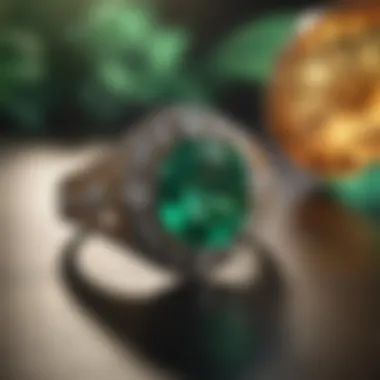
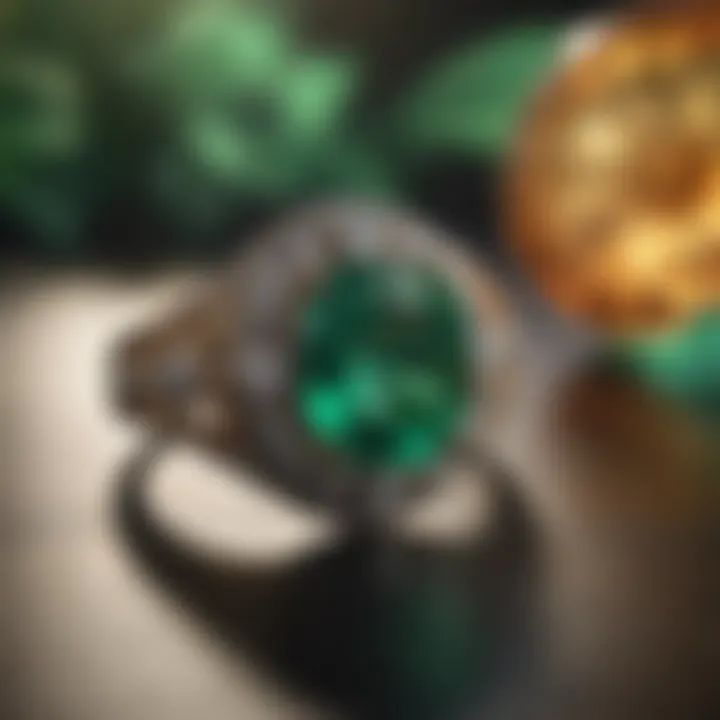
Natural vs. Synthetic Emeralds
When exploring emeralds, one cannot overlook the difference between natural and synthetic stones. Natural emeralds are formed under specific geological conditions and carry with them unique histories. In contrast, synthetic emeralds are man-made and can imitate the appearance of their natural counterparts. While synthetic stones may be more affordable and free of inclusions, they lack the character and historical value associated with natural emeralds.
"Natural emeralds possess a history woven into their existence, while synthetic emeralds serve as a reminder of human ingenuity in replicating nature's beauty."
Market Trends Influencing Emerald Ring Prices
Emerald rings have long captivated admirers, but their value doesn't solely derive from the stones themselves. Market trends play a crucial role in determining the prices of these elegant pieces. Understanding these trends can provide insight into the true worth of emerald rings and help buyers make educated choices.
Global Demand for Emeralds
The desire for emeralds has seen a significant upsurge in recent years. Globally, they are regarded as symbols of luxury and elegance. This demand can often be traced back to several factors. First, there’s the aesthetic appeal of emeralds. Many prefer the rich green hue that stands out from the typical diamond rings. Additionally, the rise of social media has introduced these jewels to a wider audience, sparking interest among younger generations.
Emerald rings are often used in engagement and wedding settings, adding to their appeal. Additionally, increased branding and marketing efforts by jewellers have attracted consumers looking for unique pieces. The demand is not only seen in high-end markets but also trickles down to more affordable options, indicating a broad interest in this gemstone.
"Emeralds are not merely jewels; they are expressions of personal taste and commitment."
This growing interest, however, also means that potential buyers should be vigilant. An uptick in demand often leads to a shift in price, where collectors and enthusiasts need to weigh the investment vs. personal satisfaction aspect carefully.
Impact of Economic Conditions
Economic situations can greatly influence the value of emerald rings. During times of economic stability, people are more willing to spend on luxury items, which results in higher prices for emeralds. Conversely, during recessions or financial downturns, discretionary spending decreases. This can lead to a decline in demand and subsequently, prices.
It's crucial for buyers to keep an ear to the ground regarding economic forecasts. An economy on the upswing generally increases purchasing power among consumers. Notably, during such periods, emerald rings seen as financial assets may fetch higher valuations.
Factors such as inflation rates, interest rates, and the overall consumer sentiment also come into play. For instance, if inflation is high, the purchasing power of consumers decreases, which can dampen the demand for non-essential goods, including emerald rings. Hence, monitoring economic indicators is essential for anyone looking to invest.
Emerging Markets and Consumer Preferences
Emerging markets are showing a growing interest in emerald jewelry. Countries like India and China, with rising middle classes, are beginning to embrace luxury goods more than ever before. The population in these regions often values precious stones traditionally, making them prime markets for emerald rings.
Culturally, preferences in jewelry are also evolving. For instance, younger consumers tend to gravitate towards unique, personalized pieces that tell a story, further increasing demand for emerald rings that boast distinct characteristics. Engagement rings are evolving too; many are stepping away from traditional diamonds and opting instead for colored gemstones, providing emeralds with an excellent platform to capitalize on.
Consumer trends are no longer just about aesthetics; they now encompass values like sustainability and ethical sourcing. Jewelers that can provide emerald rings sourced from responsible mines are likely to attract a more conscientious buyer.
Evaluating an Emerald Ring's Worth
When it comes to emerald rings, establishing their value is key for both buyers and sellers. Understanding the worth of these beautiful gems helps avoid costly mistakes. An emerald, unlike any ordinary stone, brings with it a rich tapestry of historical significance and trade dynamics that influence its market price. The value isn’t just about the stone itself; it encapsulates the craftsmanship of the setting, the legitimacy of the stone, and its emotional resonance.
Evaluating an emerald ring involves various layers—from assessing its physical properties to understanding market trends. It’s imperative for buyers to grasp how to accurately gauge what they’re paying for, while sellers need to ensure they’re asking a fair price. This discussion will delve into professional appraisals, do-it-yourself methods, and online resources, thereby equipping enthusiasts and collectors alike with the know-how to discover the genuine value of emerald rings.
Professional Appraisals
Getting a professional appraisal is perhaps the most reliable way to ascertain the value of an emerald ring. A qualified appraiser utilizes specialized equipment, including microscopes and spectrometers, to closely examine the stone and the setting. They take into consideration multiple factors such as carat weight, clarity, and color grading, aligning the gems against set industry standards. But why should anyone bother with this step?
- Accuracy: A thorough appraisal can reveal subtle aspects that the naked eye may overlook.
- Documentation: An official report can serve as a crucial document when you plan to sell or insure the ring.
- Expert Insight: Appraisers often provide invaluable advice on maintaining and enhancing the ring’s value.
"An emerald ring's appraisal is like a compass; it guides you through the murky waters of value determination."
In some cases, you may want to seek multiple appraisals to compare results and opinions, giving you a more rounded perspective of the ring's true worth.
DIY Evaluation Techniques
If you’re inclined to roll up your sleeves and do some legwork yourself, DIY evaluation techniques can be a rewarding companion to professional appraisals. While it’s essential to trust experts, understanding the basics allows you to gain confidence and knowledge about what you own. Here are a few methods you might consider:
- Simple Observation: Look for clarity marks or inclusions within the emerald. These features could significantly impact its value.
- The ‘Water Test’: This involves placing the emerald underwater to observe how much light refracts. A high-quality emerald will usually have vibrant hues and minimal cloudiness.
- Color Assessment: Natural emeralds typically exhibit a range from deep green to bluish-green. Compare your gem to established grading references to gauge its position.
However, remember that self-assessment may not capture the nuances that professionals notice. Use these techniques as a stepping stone rather than a full evaluation.
Utilizing Online Resources
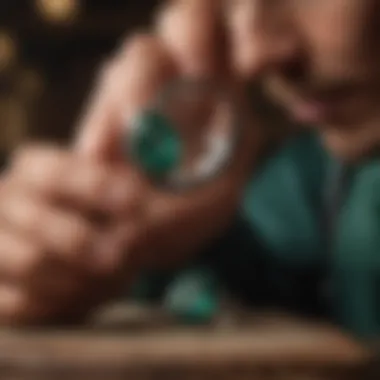
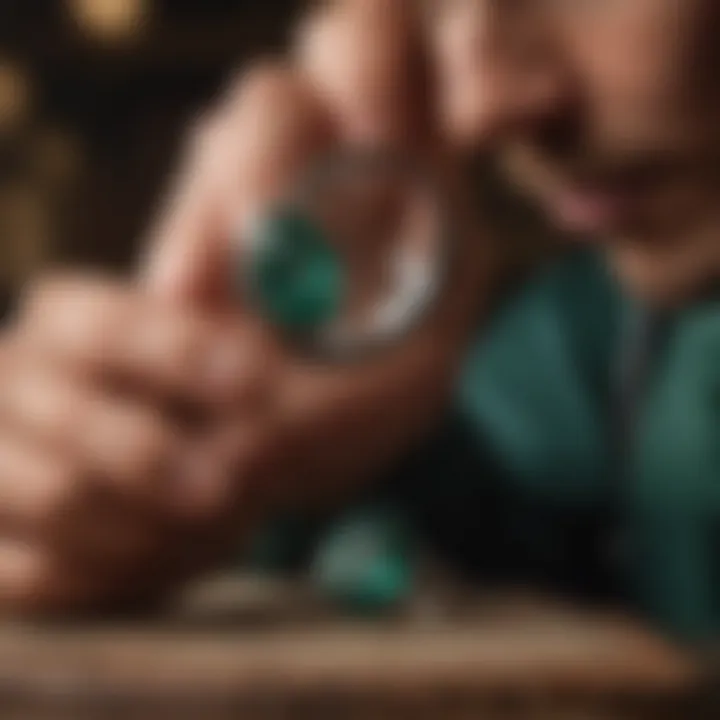
In today’s tech age, a myriad of online resources exist to help discerning collectors evaluate emerald rings. From educational websites to community forums, a wealth of information is at your fingertips. Here are a few valuable platforms:
- Educational Websites: Sites like Wikipedia and Britannica offer rich content that helps you understand the complex nature of emeralds, including grading systems and market behaviors.
- Community Forums: Platforms like Reddit host discussions where enthusiasts share insights, appraisals, and tips regarding emerald rings.
- Online Valuation Services: Some websites offer features where you can compare your emerald with similar listings, offering market-driven price insights.
Navigating these resources can keep you well-informed and provide diverse perspectives on what influences the worth of emerald rings.
Evaluating an emerald ring’s worth is a layered task that requires a mix of expert insight, self-knowledge, and resourcefulness. Each approach offers its advantages, and an informed buyer or seller is in a superior position to make shrewd choices.
Preserving the Value of Emerald Rings
When it comes to emerald rings, preserving their value is as vital as understanding the factors that affect their worth in the first place. It's not just about investment; it’s emotional too. Perhaps it was a gift passed down through generations or a symbol of a significant moment in one’s life. Whatever the case may be, each emerald ring tells a story, and maintaining its integrity ensures that story can be cherished for years to come. Careful attention to the right maintenance practices and protective measures can mean the difference between a ring losing its allure and keeping its spark alive.
Proper Care and Maintenance
Emeralds are inherently captivating, but they require a specific touch to keep their brilliance intact. Unlike diamonds, which are renowned for their toughness, emeralds are softer and more prone to scratching. Here are some key pointers to keep in mind:
- Cleaning Methods: It’s often best to clean emerald rings simply with gentle soap and lukewarm water. Avoid harsh chemicals or ultrasonic cleaners, as emeralds may have inclusions that can be further damaged by aggressive cleaning. A soft cloth or a brush designed for delicate jewelry can work wonders.
- Regular Inspections: Periodically check the settings for any loose stones or damage. The last thing you want is your precious emerald ring to lose its gemstone because of a simple oversight. Taking the gem to a professional jeweler for maintenance checks can save you from future heartache.
- Storage Solutions: When not worn, keep emerald rings separated from other jewelry. This prevents scratching and reduces the risk of tangling or clinging onto other pieces. A fabric-lined box or pouch is ideal.
- Environmental Awareness: Be mindful of the environments in which you wear your emerald rings. Activities involving intense physical movement or exposure to harsh chemicals (like in cleaning products) can lead to wear and tear. Removing rings during such occasions can prevent damage.
Insurance Considerations
Once you have taken appropriate measures to maintain your emerald ring, the next step in preserving its value is ensuring it is properly insured. Jewelry insurance offers a safety net against unforeseen circumstances that could cause financial loss. Here’s why it matters:
- Protection from Loss or Theft: If the ring is lost or stolen, being covered by insurance ensures that you can either replace it or receive compensation. Not a small consideration when thinking about the value of an emerald.
- Accidental Damage Coverage: Accidents happen, and if your ring gets damaged during wear, having specific insurance can cover repair costs. This tends to include loss of a stone or damage to the setting.
- Regular Appraisals: To keep your insurance relevant, it's a good idea to have your emerald ring appraised regularly. The market for gemstones fluctuates, and these appraisals can ensure your coverage reflects the current value of the ring.
"Insuring your jewelry is not just about protecting a financial investment; it's about safeguarding memories that are irreplaceable."
Emerald Rings in Popular Culture
Emerald rings hold a significant place in popular culture, crossing the boundaries of time, tradition, and societal trends. Their mystique and allure are reflected not only in artistic expressions but also in various facets of everyday life. The exploration of emerald rings in popular culture offers insights into how these gemstones are perceived and valued, greatly influencing market dynamics.
Emeralds in History and Mythology
Throughout history, emeralds have been symbolically intertwined with wealth, power, and protection. Ancient cultures revered these gems, believing they had the ability to enhance the intellect and bring harmony. For instance, the Egyptians associated emeralds with fertility and rebirth, often adorning their pharaohs’ tombs with them, showcasing the stones within intricate jewelry designs.
In Greek mythology, the emerald was dedicated to the goddess of love, Aphrodite, symbolizing hope and rebirth. This gemstone frequently finds its way into lore as a protective talisman. Such narratives not only heightened the desirability of emeralds but also cemented their status as tokens of fortune and enchantment.
The modern-day significance of emeralds retains some of this historical weight. Their appearance in famous jewelry collections or as part of royal adornments continues to nurture the rarity associated with these gems. Collectors and jewelry enthusiasts alike often seek pieces that echo the grandeur of history, ensuring that emerald rings remain a sought-after choice in both vintage and contemporary jewelry markets.
Contemporary Celebrity Endorsements
In today's world, celebrity endorsements can heavily sway public perception and increase the value of specific jewelry pieces. When prominent figures such as Beyoncé or Meghan Markle step out wearing emerald rings, their choices resonate widely. Fans and fashion aficionados tend to follow suit, often leading to spikes in demand and interest in emerald jewelry.
The latest emerald trends often showcase rings that are not only glamorous but carry a story, reflecting personal significance or historical legacy. As celebrities continue to flaunt their emerald jewels, the intertwining of fashion and cultural identity becomes apparent.
Moreover, many brands capitalize on this trend by creating collections inspired by celebrity styles, further enhancing the market appeal of emerald rings. When gemstones are paired with known names, it elevates them from mere jewelry to statements of identity—art pieces that echo the wearer's thoughts, values, and social standing.
In essence, the cultural significance of emerald rings extends far and wide, blending ancient beliefs with modern influences, crafting a narrative that captivates collectors, enthusiasts, and those simply drawn to beauty.
This ongoing exchange between myth, history, and contemporary fashion is essential in understanding how emerald rings are valued today, reflecting both personal and societal trends.
Ending
In comprehending the worth of emerald rings, it becomes critical to synthesize the various elements covered in this article. The conversation on emeralds with their lush green hearts and rich histories transcends mere aesthetics; it delves into a layered narrative that includes cultural significance, gemological attributes, and market dynamics. As we've navigated through this topic, one can appreciate how not just the gem itself but its surrounding factors play a vital role in determining value.
Recapitulating Key Points
- Historical Significance: Emeralds have stood the test of time, being a symbol of royalty and opulence throughout history. Understanding their backstory is essential for valuing them beyond the surface level.
- Factors Influencing Value: The well-structured elements of carat weight, clarity, color, and cut quality profoundly contribute to the pricing of an emerald ring. A slight change in any of these factors can lead to significant fluctuations in worth.
- Origin Matters: The geographical source of emeralds, like Colombian versus Zambian, brings different perceptions and values. It's not just about where the stone hails from, but how its origin can affect desirability and hence pricing.
- Market Dynamics: The global demand underscores the necessity to be attuned to changing fashion preferences and economic situations. External circumstances can sway pricing trends in surprising ways.
- Preservation: It's not merely about buying; understanding care, maintenance, and insurance considerations is paramount in preserving the investment's long-term value.
Final Thoughts on Emerald Ring Value
As we wrap up this exploration into emerald ring valuation, it becomes evident that value is an intricate web woven from history, culture, gemological specifics, and present market scenarios. The complexity of these elements speaks volumes about the timeless fascination surrounding emeralds. Collectors and enthusiasts alike can take away not only the knowledge of how to appraise these gems but also the importance of making informed decisions.
Emerald rings are more than a simple embellishment; they are heirlooms of nature that carry narratives through time. In closing, prospective buyers should focus on understanding the nuanced layers that contribute to value. Each emerald — rich in color and history — deserves careful consideration, adding an element of joy and richness to the experience of owning such treasures.
"The beauty of an emerald is not just found in its rich hue, but in the stories it holds and the value it conveys across generations."
Engaging with these jewels mindfully ensures not just a wise investment today but a cherished piece of the future.



